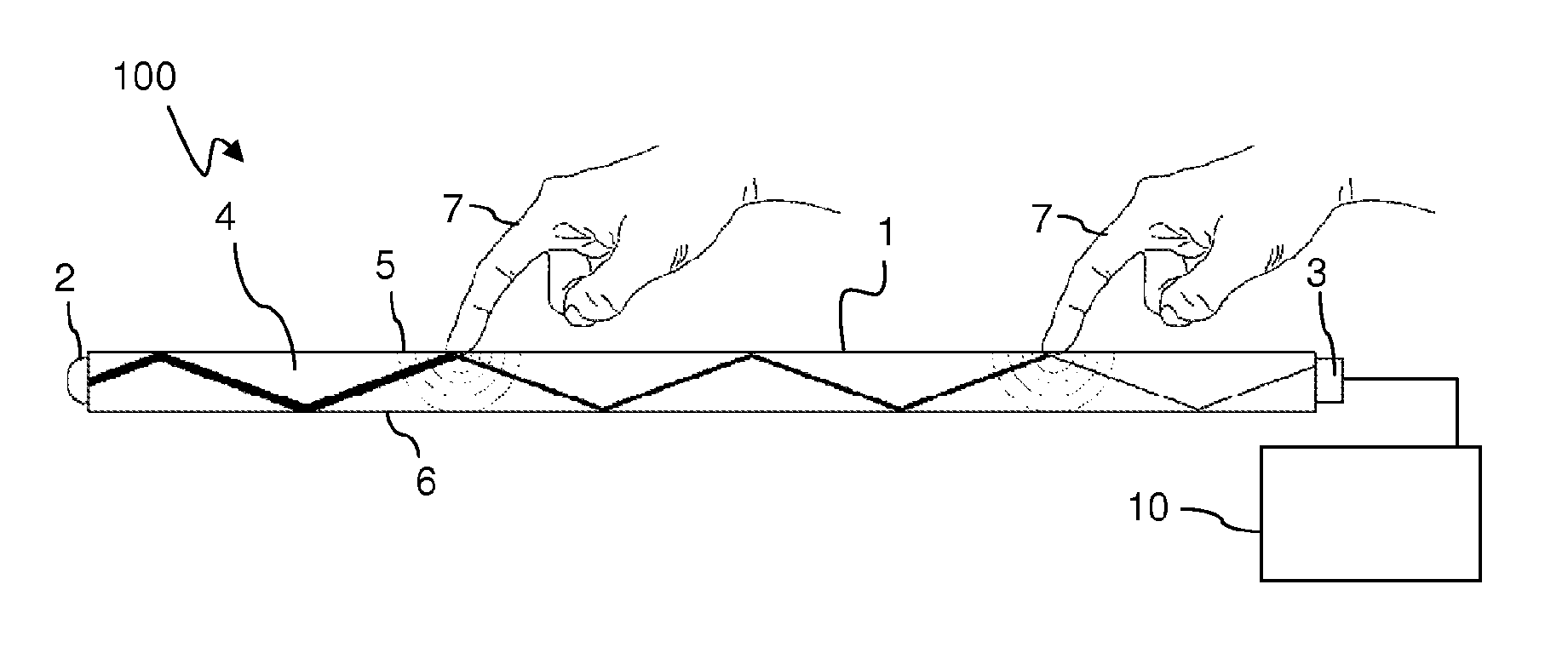Touch determination by tomographic reconstruction
a tomographic reconstruction and touch technology, applied in the field of touch-sensitive panels, can solve the problem of large noise in the 2d representation, and achieve the effect of sufficient precision
- Summary
- Abstract
- Description
- Claims
- Application Information
AI Technical Summary
Benefits of technology
Problems solved by technology
Method used
Image
Examples
first embodiment
7.2 Filtered Back Projection, First Embodiment
[0187]In a first embodiment of filtered back projection, a reconstruction line in the sample space (cf. FIG. 16) is evaluated by computing a contribution value of each sampling point to the reconstruction line and summing the contribution values. The contribution value for a sampling point is given by the product of its projection value, its adjustment factor and a filter value for the sampling point.
[0188]In this embodiment, the reconstruction function F(ρk,g(φk,sk)) is given by
[0189](ℛ#v)(xi)=∑kρk·wb(sk-xi·θk)·g(φk,sk).
[0190]The time complexity of the reconstruction function is O(n4). In this function, g(φk,sk) is the projection value of detection line k, (φk,sk) is the position of the detection line k in the sample space, and wb(Δs) is the 1D filter given as a function of distance Δs to the reconstruction line in the s dimension. The distance is computed as Δs=sk−xi·θk where xi is the reconstruction point (in the attenuation fiel...
second embodiment
7.3 Filtered Back Projection, Second Embodiment
[0194]In a second embodiment of filtered back projection, a reconstruction line in the sample space is evaluated by extending the influence of the sampling points by the use of interpolating basis function and by including the 1D filter in the reconstruction line.
[0195]In this embodiment, the reconstruction function F(ρk,g(φk,sk)) is given by
[0196](ℛ#v)(xi)=∑kρk·g(φk,sk)
[0197]In this embodiment, the adjustment factor ρk may be any adjustment factor originating from a surface integral through interpolating basis functions in the sample space, such as ρk,iwD1 or ρk,iwV0.
[0198]The time complexity of the reconstruction function is O(n4). It can be noted that the time for executing the reconstruction (cf. step 24 in FIG. 10A) is largely independent of the selected interpolating basis function and 1D filter, given that adjustment factors are typically pre-computed and stored in memory. The time spent for this pre-computation may however b...
third embodiment
7.4 Filtered Back Projection, Third Embodiment
[0200]In a third embodiment of filtered back projection, the filtering step is performed locally around each individual sampling point in the sample space using the 1D filter. The filtering is operated on synthetic projection values at synthetic sampling points which are generated from the projection values of the sampling points, e.g. by interpolation. The synthetic projection values are estimated signal values that are generated around each projection value at given locations in the s dimension. FIG. 24A illustrates a few actual sampling points (stars) and associated synthetic sampling points (circles) in a subset of the φ-s-plane of FIG. 9. FIG. 24A also illustrates Delaunay triangles (dotted lines) that may be used for interpolation of the synthetic sampling points. The actual sampling points are thus placed at the corners of a mesh of non-overlapping triangles, and the values of the synthetic sampling points are e.g. linearly interp...
PUM
 Login to View More
Login to View More Abstract
Description
Claims
Application Information
 Login to View More
Login to View More - R&D
- Intellectual Property
- Life Sciences
- Materials
- Tech Scout
- Unparalleled Data Quality
- Higher Quality Content
- 60% Fewer Hallucinations
Browse by: Latest US Patents, China's latest patents, Technical Efficacy Thesaurus, Application Domain, Technology Topic, Popular Technical Reports.
© 2025 PatSnap. All rights reserved.Legal|Privacy policy|Modern Slavery Act Transparency Statement|Sitemap|About US| Contact US: help@patsnap.com



